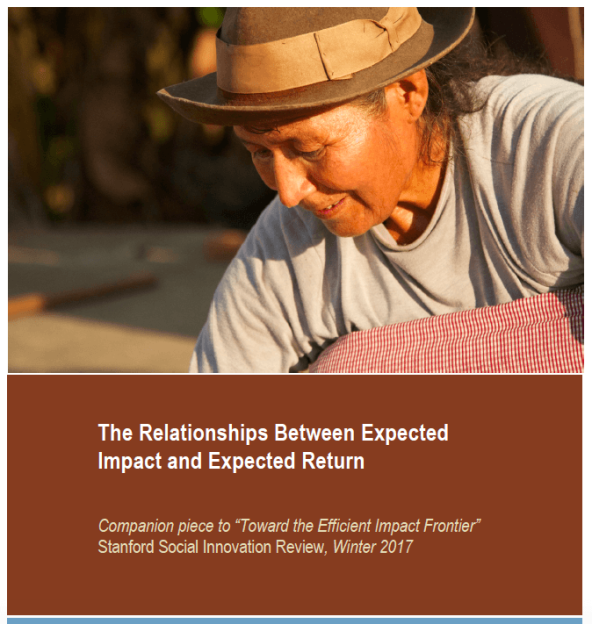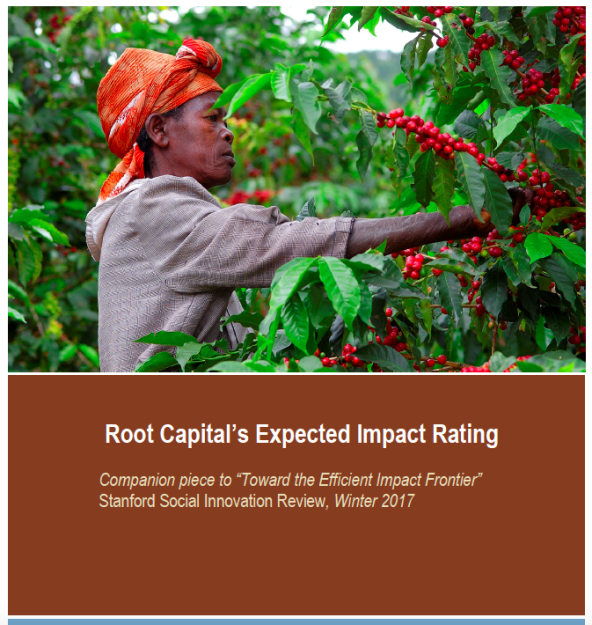The field of impact investing is new enough that practitioners do not yet have a single shared approach to defining and measuring either “impact” or financial “return.” Yet the field has now advanced to a point where several organizations have designed sophisticated models not only for measuring the expected impact and the expected return of their investments, but also for analyzing the connections (and the potential trade-offs) between those crucial variables. One such organization is Root Capital, a lender that focuses on supporting agricultural businesses in developing countries. McCreless, senior director of strategy and impact at that organization, provides an overview of tools used by Root Capital in “Toward the Efficient Impact Frontier,” a feature article in the Winter 2017 issue of SSIR. Among those tools are the “expected return rating,” the “impact/return hurdle rate,” and the tool cited in his title.
To supplement the article, we share two documents that McCreless and his colleagues have developed in order to provide more detail on these tools—and on what Root Capital has learned while using them.
The efficient impact frontier is a tool that intentionally simplifies the way that expected impact and expected return interact within a given portfolio of investments. But for an investor like Root Capital, the relationships between impact and return that exist at a loan-by-loan level involve a high degree of complexity. In this document, McCreless and his colleagues tease out some of the connections that they have observed between the expected impact and the expected return of loans in their organization’s portfolio.
The Relationships Between Expected Impact and Expected Return

“[G]oing where the need is greatest costs more. In this regard, there is a tradeoff between impact and financial return. … In other regards, achieving higher impact doesn’t mean accepting a lower financial return. For Root Capital, loans to enterprises with stronger social and environmental performance—as distinguished from enterprise and farmer need—tend to have higher expected returns.”—from the “Relationships” document
Download the complete document here.
Defining what “impact” means in the context of impact investing is an inherently complex and famously difficult task. It encompasses a wide range of discrete but essential forms of impact: social impact and environmental impact, the impact that an enterprise achieves directly and the impact that arises from an investor’s support of that enterprise (a factor that is also known as “additionality”). To integrate these forms of impact into a single usable metric, Root Capital has created a tool that it calls an “expected impact rating.” In this document, McCreless and his colleagues elaborate on their use of this tool.
Root Capital’s Expected Impact Rating

“The indicators in the Rating are proxies for the types of impact we seek, and some are better proxies than others. … The assumptions behind any expected impact rating need to be validated by ex-post impact evaluations. … Our purpose is not to advocate for impact ratings in general, or ours specifically. We introduced the expected impact index simply because it was a necessary stepping-stone towards our efficient impact frontier.”—from the “Expected Impact Rating” document
Download the complete document here.
Support SSIR’s coverage of cross-sector solutions to global challenges.
Help us further the reach of innovative ideas. Donate today.
Read more stories by SSIR Editors.

